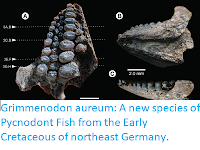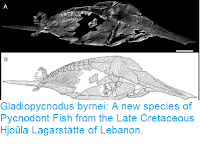Pycnodont Fish were a highly successful group of Ray-finned Fish, Actinopterygii, that tended
to be highly laterally compressed, with deep
bodies, and lacked the evertable jaws of modern Teleosts, but often had
specialised dentition, with many species apparently being durophagous (adapted to crush the shells of organisms such as Molluscs).
They first appeared in the Late Triassic of Europe, and became a
dominant group of Fish in many ecosystems in the Late Jurassic and
Cretaceous, finally going extinct around the end of the Eocene. However Pycnodont Fish from the Early and Middle Jurassic
are very rare, with only about twelve species known, suggesting that
this group was very badly affected by the End Triassic Extinction.
In a paper published in the journal Current Biology on 18 October 2018, Martina Kölbl-Ebert and Martin Ebert of the Jura-Museum Eichstätt of the Staatliche Naturwissenschaftliche Sammlungen Bayerns, David Bellwood of the College of Science and Engineering and ARC Centre of Excellence for Coral Reef Studies at James Cook University, and Christian Schulbert of the GeoZentrum Nordbayern at the Friedrich-Alexander Universität Erlangen-Nürnberg, describe a remarkable new Pycnodont Fish from the Solnhofen Limestone of Bavaria.
The new species is described from a single, almost complete specimen on a split limestone block. It is 7.1 cm in length, and has the usual Pycnodont shape, with a deep but strongly compressed body, but differs from all over known Pycnodonts in its dentition, having triangular, dagger-shaped teeth, reminiscent of a modern Piranha. The new species is named Piranhamesodon pinnatomus, where 'Piranhamesodon' is a combination of 'Piranha' and 'Mesodon' a previously described species of Pycnodont, and 'pinnatomus' means 'fin-cutter'.
The Pycnodontiform Piranhamesodon pinnatomus, 7.1 cm standard length, from the Late Jurassic of Ettling, Solnhofen Archipelago, Germany, the earliest fin-cutting Piranha-like Ray Finned Fish. Martin Ebert in Kölbl-Ebert et al. (2018).
A number of other species of Fish described from the Solnhoffen Limestone have been observed to have had what appear to be bite-marks on their fins, consistent with having been attacked by some unknown predator, though no likely candidate has been available to date; numerous Fish species have previously been described from these deposits, but none has had appropriate dentition to do this sort of damage. Kölbl-Ebert et al. suggest that Piranhamesodon pinnatomus would be a very good candidate for causing such damage, as it has both Piranha-like dentition, and a morphology which, like that of other Pcynodonts, is suggestive of a very hard biting-capacity. Coming from the Late Jurassic, Piranhamesodon pinnatomus is not only an example of convergent evolution with modern Piranhas, but is the oldest known example of a Ray-finned Fish with specialist cutting teeth.
See also...
Follow Sciency Thoughts on Facebook.







